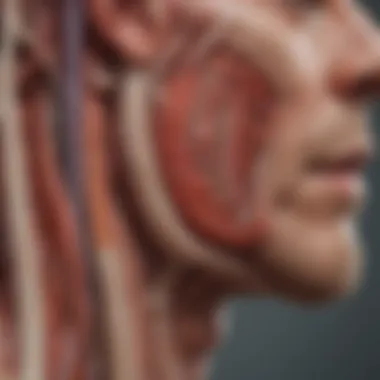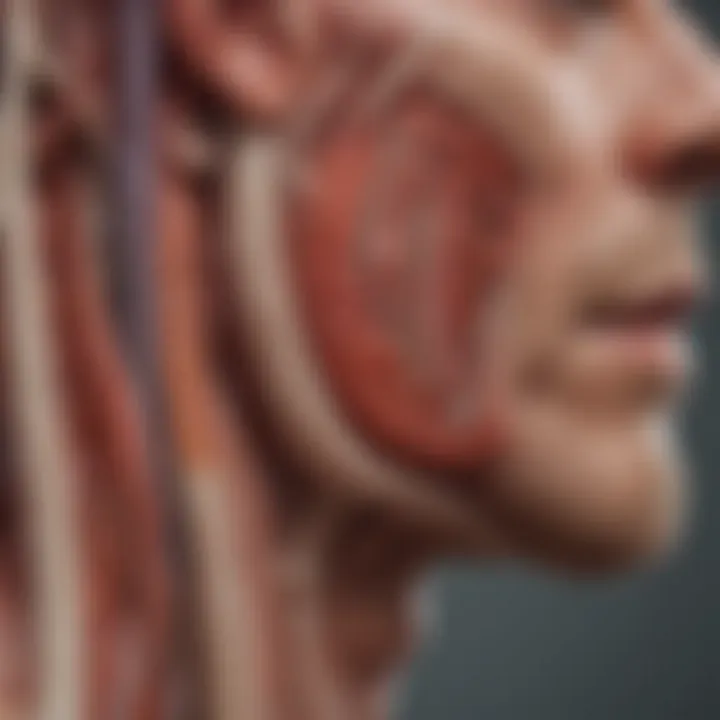Understanding Muscle Atrophy: Causes and Recovery


Intro
Muscle atrophy is a significant health concern that can affect individuals at various stages of life. It refers to the loss of muscle mass, which can result from numerous factors including age, inactivity, illness, and malnutrition. Understanding muscle atrophy is crucial for health professionals, researchers, and anyone interested in health and wellness. This condition can lead to physical limitations, decreased strength, and an overall decline in quality of life.
To tackle the complexities surrounding muscle atrophy, it is essential to explore its definitions, causes, types, and effects on the human body. This article attempts to not only explain the physiological mechanisms behind muscle wasting but also to discuss the various conditions that contribute to this phenomenon.
Additionally, insights into potential recovery strategies and preventative measures will be provided. By examining both biological and clinical aspects, a comprehensive view of muscle atrophy is achieved, making this an important subject for readers seeking to understand its implications and insights.
Research Overview
Methodological Approaches
Research on muscle atrophy has relied on a combination of clinical studies, animal models, and laboratory experiments. Various methodologies are utilized to gain insights into the underlying mechanisms of muscle loss. For example:
- Clinical studies often assess muscle mass using imaging techniques such as MRI or ultrasound.
- Animal models help explore the metabolic pathways involved in muscle wasting and regeneration.
- In vitro experiments enable scientists to analyze cellular mechanisms in a controlled environment.
These approaches foster a multifaceted understanding, contributing to the broader scope of knowledge surrounding atrophy.
Significance and Implications
The implications of muscle atrophy extend beyond individual health concerns. This phenomenon influences public health, healthcare costs, and rehabilitation practices. Understanding atrophy can lead to better clinical outcomes. Recognizing risk factors and early signs can facilitate timely intervention strategies.
Research has shown that integrating strength training and nutritional support might aid in reversing muscle loss. Therefore, the significance of continued study in this area remains high, as it informs effective health promotion and recovery strategies.
"Muscle atrophy not only affects the individual’s physical capabilities but also poses broader implications for health systems and society at large."
Current Trends in Science
Innovative Techniques and Tools
Recent advancements in technology have opened new avenues for studying muscle atrophy. Innovative tools may include:
- Wearable devices that monitor physical activity levels, providing real-time data on muscle usage.
- Advanced imaging techniques that allow more precise measurements of muscle composition and function.
- Biochemical assays to analyze the molecular factors that contribute to muscle wasting.
These innovations enhance the capacity for researchers to track muscle health and develop targeted therapies.
Interdisciplinary Connections
The study of muscle atrophy intersects various disciplines such as biology, medicine, and kinesiology. Collaborations among researchers from these fields encourage comprehensive strategies towards understanding and managing atrophy. Interdisciplinary efforts may nurture breakthroughs in treatment protocols and preventive measures, highlighting the importance of a holistic approach in health science.
Preamble to Muscle Atrophy
Muscle atrophy is a significant health concern that touches various aspect of physiology and general wellness. Understanding this phenomenon can help individuals recognize its implications in both daily life and clinical settings. Muscle atrophy refers to the reduction in muscle mass, affecting strength and functionality. This section aims to clarify what muscle atrophy is and explore its historical perspective, which is crucial in grasping the present state of knowledge in this field.
Definition of Muscle Atrophy
Muscle atrophy is defined as a decrease in the size, strength, and number of muscle fibers. It can occur for various reasons, including disuse, disease, and aging. The condition is often characterized by visible shrinkage of muscles and overall weakness, leading to decreased physical performance. Importantly, muscle atrophy is not merely a cosmetic issue; it can have profound effects on metabolism and overall health. The understanding of muscle atrophy is crucial for developing effective treatment and rehabilitation plans for affected individuals.
Historical Context
Historically, muscle atrophy has been observed and documented since ancient times. Hippocrates noted the effects of inactivity on muscle health in his writings. However, it wasn't until the late 19th century that scientists began to study muscle wasting in detail. The research has since evolved, leading to comprehensive knowledge of the physiological mechanisms involved.
Famous studies in the 20th century highlighted the relationship between disuse and muscle atrophy. This research has significant implications for clinical practices today. As we enter an era focused on personalized medicine and rehabilitation, understanding muscle atrophy is more relevant than ever. The evolution of this understanding reflects a broader awareness of how lifestyle factors impact health and recovery.
Physiological Mechanisms of Muscle Atrophy
Understanding muscle atrophy involves examining its physiological mechanisms. This depth of knowledge helps pinpoint how muscle wasting occurs on a cellular and hormonal level. Recognizing these mechanisms is critical for effective treatment and prevention strategies. By analyzing various factors that contribute to muscle atrophy, one can better address the implications it has on health.
Cellular Processes Involved
Role of Myostatin
Myostatin is a protein that plays a significant role in muscle regulation. It inhibits muscle growth, acting as a natural brake on muscle development. Elevated levels of myostatin can contribute to muscle atrophy by slowing down the process of muscle repair and regeneration. This characteristic is crucial because it demonstrates how control over myostatin can potentially lead to methods for reducing muscle wasting. Targeting myostatin might offer a beneficial way to counteract the adverse effects of atrophy, especially in older adults or individuals with muscle wastage diseases.
The distinct feature of myostatin lies in its dual role; while it prevents excessive muscle growth, its overactivity can lead to undesirable outcomes, emphasizing the need for balance. In the context of muscle atrophy, managing myostatin levels appears to have notable advantages. However, some treatments aiming to downregulate myostatin might also risk promoting unwanted muscle growth, presenting challenges in developing effective therapies.
Apoptosis in Muscle Cells
Apoptosis refers to the programmed cell death process. In muscle cells, apoptosis can contribute to muscle atrophy by removing cells that might otherwise regenerate. This process is essential for maintaining tissue homeostasis, although excessive apoptosis can have detrimental effects on muscle mass.
The key characteristic of apoptosis in muscle cells is that it often occurs in response to stressors, including inactivity or hormonal changes. Understanding the relationship between apoptosis and muscle atrophy is vital because it presents therapeutic targets. Potential interventions could aim to reduce excessive apoptosis, thereby preserving muscle mass in at-risk populations.
The unique feature of apoptosis is its complexity; it is a natural and necessary process but can become harmful in the context of muscle atrophy. The advantages of controlling this process are evident, yet there are potential disadvantages. For instance, inhibiting apoptosis could lead to unwanted cellular accumulation, possibly complicating muscle recovery efforts.
Hormonal Regulation
Effects of Cortisol
Cortisol is a hormone that exerts significant influence over muscle metabolism. Often referred to as the stress hormone, it can impact muscle tissue negatively. Elevated cortisol levels can stimulate muscle protein breakdown, contributing to muscle atrophy. This connection highlights cortisol's role as a key player in muscle health, especially during times of prolonged stress or illness.
The main characteristic of cortisol's influence is its catabolic effect on muscle tissue. By understanding how cortisol elevates and regulates in response to stress, one can develop strategies to mitigate its harmful effects. Managing cortisol levels presents a feasible choice in addressing muscle atrophy, as reducing stress and promoting recovery can lead to improved muscle health.
The unique aspect of cortisol is its dual nature; while necessary for many bodily functions, excess levels can be destructive to muscle integrity. Effective management of cortisol can be advantageous, as it can help preserve muscle mass, yet it requires careful monitoring as cortisol also has vital regulatory functions in the body.
Insulin's Role
Insulin is another hormone that plays a pivotal role in muscle health. It facilitates nutrient uptake and promotes protein synthesis in muscles. Low insulin levels, often seen in poorly managed diabetes or during prolonged fasting, can lead to muscle atrophy due to inadequate nutrient supply to muscle cells.
The key characteristic of insulin in this context is its anabolic effect, supporting muscle growth and repair. Its importance in this article arises from understanding how insulin resistance can exacerbate muscle wasting, revealing links between metabolic health and muscle preservation.


The unique feature of insulin's role in muscle regulation is that while it aids in muscle growth, its ineffectiveness in certain conditions leads to negative outcomes. Emphasizing the regulation of insulin can provide substantial advantages in combating muscle atrophy. However, individuals must be cautious about insulin management to avoid risk of developing hypoglycemia or excessive fat accumulation.
Types of Muscle Atrophy
Understanding the various types of muscle atrophy is crucial for grasping the full extent of this condition. Each type has distinct characteristics, underlying causes, and implications. This section will delve into the specifics of disuse atrophy, neurogenic atrophy, and cachexia. By differentiating these types, the article aims to illuminate how muscle atrophy manifests in different contexts and how it can be addressed effectively.
Disuse Atrophy
Causes and Examples
Disuse atrophy occurs when muscles are not actively used over extended periods. A common cause of this is prolonged bed rest, such as during recovery from surgery or chronic illness. Other examples include immobilization due to fractures or lack of physical activity in sedentary lifestyles.
The key characteristic of disuse atrophy is its reversible nature. With appropriate intervention, such as physical rehabilitation and engaging in regular exercise, muscle mass can often be regained effectively. The focus on disuse atrophy makes it a relevant topic for this article, as many individuals face this issue due to modern lifestyle habits.
Impact on Health
Disuse atrophy can lead to several adverse health consequences. The most significant impact is the loss of strength, which can affect daily activities and overall quality of life. Individuals may experience difficulties in performing simple tasks, leading to a cascade of further health issues, such as decreased mobility and increased risk of falls.
Moreover, disuse atrophy can have detrimental effects on metabolic health as well. Muscle plays a critical role in glucose metabolism. Reduced muscle mass can lead to impaired insulin sensitivity and increased risk of metabolic disorders. Thus, understanding the impact of disuse atrophy is essential for developing effective health strategies.
Neurogenic Atrophy
Neurological Disorders
Neurogenic atrophy is often caused by neurological disorders that affect the nerves controlling muscle movements. Conditions like amyotrophic lateral sclerosis and multiple sclerosis are prime examples. The major concern here is that muscle tissue is not receiving the necessary signals from nerves, leading to muscle wasting over time.
The key characteristic of neurogenic atrophy is the involvement of the nervous system, which makes it distinct from other types. This aspect is beneficial for this article as it highlights the interplay between muscles and the nervous system, showcasing a broader physiological context.
Diagnosis Challenges
Diagnosing neurogenic atrophy can be challenging. The symptoms can often mimic other conditions, leading to misdiagnosis or delayed treatment. Specific tests, such as electromyography, are required to accurately determine the extent of nerve damage.
The unique feature of diagnosis challenges lies in the need for specialized medical evaluation. This emphasizes the importance of early detection and accurate diagnosis in managing neurogenic atrophy effectively.
Cachexia
Link to Chronic Diseases
Cachexia is a complex syndrome associated with chronic diseases such as cancer, heart failure, and chronic obstructive pulmonary disease. It is characterized by severe weight loss, muscle wasting, and fatigue. The connection between cachexia and chronic illness is crucial because it extends beyond simple malnutrition.
The key characteristic of the link between cachexia and chronic diseases is the severe physiological changes that occur due to the underlying condition. Understanding this connection is beneficial for this article as it underscores the necessity of comprehensive treatment approaches that address both the disease and its associated muscle wasting.
Clinical Implications
The clinical implications of cachexia are significant. Cachexia can drastically affect treatment outcomes and increase morbidity. Patients with cachexia may experience reduced tolerance to therapies, leading to a need for adjusted strategies in managing their care.
The unique aspect of clinical implications of cachexia emphasizes the importance of a multidisciplinary approach. Nutrition, physical therapy, and medical management must be integrated to effectively address the needs of individuals suffering from this condition.
Causes of Muscle Atrophy
Muscle atrophy is a significant health concern that arises from various factors. Understanding its causes is essential for both prevention and treatment. The causes of muscle atrophy can be diverse, but they often stem from lifestyle choices, chronic illnesses, and aging. Each of these categories encompasses distinct mechanisms that contribute to muscle wasting. Recognizing these causes allows for targeted interventions and an improved quality of life for affected individuals.
Sedentary Lifestyle
Impact of Inactivity
A sedentary lifestyle is a major contributor to muscle atrophy. The lack of regular movement leads to muscle disuse, which can result in a decrease in muscle mass and functional strength. Research has shown that prolonged inactivity causes a shift in the balance between muscle protein synthesis and degradation, favoring muscle loss. This loss is not just physical; it can significantly affect overall health, leading to conditions such as obesity and metabolic disorders.
The key characteristic of inactivity is its pervasive nature in modern society. With many individuals spending long hours sitting at desks or engaged in screen time, the opportunity for movement is often overlooked. Thus, the need to address this aspect is crucial for preventing muscle atrophy. The unique feature of inactivity is that it can often be adjusted with simple lifestyle changes. Encouraging regular breaks to stand or walk can mitigate some disadvantages associated with prolonged sitting.
Recommendations for Movement
In light of the consequences of inactivity, recommendations for movement become essential. Engaging in physical activity not only helps prevent muscle atrophy but also improves mental well-being. Regular movement encourages blood circulation, enhances muscle strength, and supports joint health. A balanced routine that involves both aerobic exercises and resistance training can provide comprehensive benefits.
The unique aspect of these recommendations is their adaptability to individual lifestyles. People can incorporate physical activity in various ways, such as taking stairs instead of elevators or engaging in short walks during breaks. This flexibility makes the recommendations widely applicable and beneficial. However, the challenge remains in maintaining a consistent routine, requiring dedication and motivation from individuals.
Chronic Illness
Cancer
Chronic illnesses such as cancer play a significant role in muscle atrophy. Cancer-related cachexia is a condition characterized by severe weight loss and muscle wasting, which can occur even in individuals with adequate food intake. The disease alters metabolism and increases inflammation, contributing to muscle breakdown. This aspect emphasizes the importance of monitoring muscle mass in patients with cancer, as it can significantly affect treatment outcomes and quality of life.
The key characteristic of cancer in relation to muscle atrophy is its dual impact on the body: it not only fights the illness but also promotes muscular decline. Understanding this relationship is crucial for healthcare professionals to offer effective support. The unique feature of cancer is that it often involves a multidisciplinary approach in treatment, requiring collaboration among oncologists, nutritionists, and physical therapists to mitigate its effects on muscle health.
Heart Failure
Heart failure is another chronic condition that contributes to muscle atrophy. The reduced blood flow and oxygen delivery to muscles can lead to disuse and deterioration. The physical limitations caused by heart failure can create a cycle where decreased activity results in more severe muscle loss. Such effects can compound the overall health decline in these patients.
The key characteristic of heart failure is its impact on both muscular and cardiovascular health. Understanding how these systems interact is essential for developing comprehensive treatment plans. A unique feature of heart failure is that interventions can often focus on rehabilitation programs designed to improve heart function alongside muscle strength, demonstrating that integrated care is profoundly beneficial.
Aging
Sarcopenia Defined
Aging is a natural phenomenon that affects muscle health through a condition known as sarcopenia. Sarcopenia refers to the age-related loss of muscle mass and function. This process can begin as early as the thirties, leading to significant declines in strength and endurance in later years. Understanding sarcopenia is vital as it is a common contributor to falls and disability among the elderly.
The key characteristic of sarcopenia is its gradual progression, often going unnoticed until significant loss occurs. Recognizing and addressing sarcopenia early can greatly improve health outcomes and maintain independence in older adults. The unique aspect of sarcopenia is that it can often be countered with a combination of resistance training and proper nutrition, making preventative measures crucial.
Preventative Measures
Implementing preventative measures for muscle atrophy due to aging involves several strategies. Regular exercise, particularly strength training, is widely recommended to preserve muscle mass. Adequate protein intake is also vital, as it plays a direct role in muscle synthesis. Nutritional education and tailored exercise plans can empower older adults to take control of their muscle health.


The key characteristic of these measures is their focus on lifestyle modification. Encouraging older individuals to remain active and engaged can have long-term benefits. The unique feature of these preventative strategies is their effectiveness in enhancing overall quality of life. By adopting sustainable habits, older adults can significantly delay the onset of sarcopenia and improve their physical capabilities.
Effects of Muscle Atrophy on the Body
The concept of muscle atrophy is crucial to understand, particularly its effects on the body. Muscle atrophy refers to the loss of muscle mass and strength, which can have wide-ranging implications for overall health. It is not merely a cosmetic issue but influences functional capacity, metabolic health, and quality of life.
Strength and Endurance Loss
One immediate consequence of muscle atrophy is the significant loss of strength and endurance. Muscles are essential for movement and physical activities. When they weaken due to atrophy, simple tasks like climbing stairs or carrying groceries become challenging. This decline can set off a cycle of decreased physical activity, which further exacerbates muscle loss. Additionally, individuals may experience fatigue more quickly during exertion, impacting their motivation to engage in exercise or physical rehabilitation. Maintaining strength is vital because it supports all bodily functions and contributes to stability, reducing the risk of falls and injuries.
Metabolic Consequences
The metabolic consequences of muscle atrophy also deserve attention. Loss of muscle mass leads to lower basal metabolic rate, which makes energy expenditure less efficient. This can lead to weight gain and other health issues.
Impact on Energy Levels
The impact on energy levels due to muscle atrophy is significant. Loss of muscle leads to decreased energy availability for everyday activities. This lower energy can translate into reduced overall physical activity, creating a loop where the body further loses muscle. Moreover, individuals may become more lethargic or less motivated, which can worsen their physical condition.
- Key characteristic: A reduced metabolic rate means more calories stored as fat rather than used.
- Relevance: Recognizing this shift is pivotal when devising strategies for recovery and rehabilitation.
Effects on Nutrition
Effects on nutrition also arise from muscle atrophy. When muscle mass decreases, nutritional needs can change. Individuals may find it harder to maintain a balanced diet that supports both their energy needs and muscle recovery.
- Key characteristic: Protein intake becomes critical in efforts to rebuild muscle tissue.
- Importance: Understanding these nutritional needs can help in creating targeted dietary plans that address muscle loss while promoting recovery.
"Managing muscle health is as vital as addressing any other aspect of well-being."
In summary, the effects of muscle atrophy extend beyond simple muscle loss; they are complex and interconnected with overall health and daily functioning. With a clear understanding of these impacts, individuals can take informed steps towards prevention and recovery.
Assessment and Diagnosis
Assessment and diagnosis play a critical role in understanding muscle atrophy. Proper evaluation of muscle wasting can lead to insightful conclusions about underlying health issues. Assessing muscle atrophy involves a combination of clinical evaluations, imaging techniques, and, in some cases, biopsy procedures. Each of these elements provides valuable information that helps healthcare professionals tailor appropriate treatment plans.
Clinical Evaluation
A thorough clinical evaluation is the cornerstone of diagnosing muscle atrophy. This process typically involves a detailed patient history followed by a physical examination. Providers look for signs of muscle weakness and evaluate muscle mass through visual inspection and palpation. Questions surrounding the patient’s lifestyle, diet, and pre-existing conditions are crucial. This build a complete profile.
Key aspects to note:
- Family history of muscle disorders.
- Any recent changes in physical activity.
- Nutritional habits that may affect muscle health.
This evaluation not only identifies muscle atrophy but also helps establish potential treatments and rehabilitation goals.
Imaging Techniques
Imaging techniques are integral to diagnosing muscle atrophy. Two prominent methods are Magnetic Resonance Imaging (MRI) and Computed Tomography (CT) scans.
MRI
Magnetic Resonance Imaging (MRI) is a non-invasive technique that provides detailed images of muscle tissue. One key characteristic of MRI is its ability to capture high-resolution images without using ionizing radiation, making it a safer option for repeated assessments. MRI can visualize differences in muscle composition, identifying areas of atrophy or degeneration.
Unique features of MRI include:
- Contrast enhancement options that highlight specific tissues.
- Capability to assess surrounding soft tissues and structures.
Advantages of MRI are significant; the detailed images it provides allow for a precise diagnosis. However, MRI is time-consuming and may be costly compared to other imaging methods.
CT Scans
Computed Tomography (CT) scans also serve to evaluate muscle atrophy by generating cross-sectional images of the body. One of CT’s defining characteristics is its speed, making it a quick process for patients. Moreover, CT can be especially useful for assessing muscle mass in large body areas.
Important aspects include:
- Ability to quickly scan and evaluate multiple regions of the body.
- Clear imaging of bone and soft tissue which helps in evaluating associated conditions.
Nevertheless, CT scans expose patients to more radiation than MRIs, which is a major consideration when opting for this method. CT scans can also be less detailed for soft tissue assessment compared to MRI.
Biopsy Procedures
Biopsy procedures are sometimes necessary when imaging does not provide a complete picture. They involve taking a small sample of muscle tissue to analyze it under a microscope. This can yield information about conditions like inflammatory myopathy or other muscle diseases.
The drawback of biopsies is that they are invasive and carry certain risks, such as infection or complications from the procedure. However, the detailed cellular analysis they provide can be pivotal in confirming a diagnosis and guiding treatment.
Recovery and Rehabilitation
Recovery and rehabilitation are essential components in addressing muscle atrophy. These processes aim not just to regain lost muscle mass, but also to restore functional capacity and improve overall quality of life. Often, individuals facing muscle atrophy have encountered significant physical limitations, making it crucial to engage in structured recovery programs. Rehabilitation typically involves both physical and nutritional strategies that work in tandem to optimize healing and strengthen muscle tissue.
Incorporating effective recovery methods can enhance physical potential and prevent future occurrences of muscle atrophy. A multidisciplinary approach that includes physical therapy, exercise regimens, and nutritional planning is important. Additionally, understanding personal limits and adjusting activities accordingly is vital. This ensures that recovery is both safe and effective.
Moreover, rehabilitation is not merely a return to previous activity levels; it also focuses on improving overall muscle function, flexibility, and endurance. The long-term goal is to foster sustainable habits that promote health and fitness.
Physical Therapy Approaches
Physical therapy approaches are foundational in the journey to recovery. They facilitate not only muscle rebuilding but also alleviate pain and improve mobility. A physical therapist often designs a tailored program that considers an individual's specific needs and capabilities.
Common techniques employed may include:
- Strength training: This helps in rebuilding muscle fibers and increasing overall muscle strength.
- Range of motion exercises: These promote flexibility and decrease stiffness in muscles.
- Aerobic conditioning: Enhances cardiovascular fitness and supports metabolic health.


A key advantage of physical therapy is its adaptability. Patients can modify their exercises based on progress or setbacks, thus inspiring a sense of ownership and control in their recovery process.
Nutritional Strategies
Nutritional strategies play a critical role in recovery from muscle atrophy. Proper nutrition can greatly enhance muscle repair and growth, especially when combined with physical therapy.
Protein Intake
Protein intake is crucial for muscle recovery, as it provides the building blocks for muscle tissue. Protein is beneficial because it directly contributes to muscle synthesis and repair after exercise. The key characteristic of protein is its ability to stimulate muscle protein synthesis, which can enhance recovery outcomes.
A unique feature of protein is the variety available, such as whey, casein, and plant-based options. Each type has advantages; for instance, whey protein is quickly absorbed, making it ideal post-exercise. However, some might prefer plant proteins due to dietary restrictions.
Incorporating the right amount of protein into one’s diet can lead to significant improvements in muscle mass and function. Care must be taken to balance protein with other essential nutrients to ensure holistic recovery.
Vitamin Importance
Vitamin D plays an instrumental role in muscle recovery and function. This vitamin is vital for calcium absorption, which indirectly supports muscle function and bone health. The key characteristic of vitamin D is its involvement in muscle strength and performance.
A unique feature of vitamin D is its dual role; it supports both muscle and immune function. Its deficiency is linked with increased risk of muscle weakness and potential atrophy. Ensuring adequate vitamin D levels can provide advantages such as improved muscle strength and a decrease in injury risk, particularly in older adults.
In summary, both protein intake and vitamin D are fundamental in addressing muscle atrophy through proper nutrition. Care should be taken to monitor and adjust dietary habits, thus maximizing recovery outcomes and overall health.
Prevention of Muscle Atrophy
Understanding how to prevent muscle atrophy is crucial for maintaining overall health and well-being. A proactive approach can delay the onset of muscle wasting, particularly in populations at risk. Prevention strategies aim to minimize muscle loss resulting from disuse, disease, and aging. Such measures enhance not only physical health but also the quality of life for individuals.
Exercise and Physical Movement
Resistance Training
Resistance training plays a vital role in combating muscle atrophy. This type of exercise involves working against any force, typically using weights or resistance bands. It promotes muscle hypertrophy, which is the increase in muscle size. Furthermore, strength training enhances bone density and boosts metabolism.
A key characteristic of resistance training is its ability to stimulate growth in skeletal muscles through progressive overload. By gradually increasing the weight or resistance, muscles are encouraged to adapt and grow stronger. This feature makes resistance training a popular choice in rehabilitation programs aimed at reversing atrophy or preventing its development.
However, it is essential to approach resistance training with caution. Improper techniques can lead to injuries. Individuals should consider seeking guidance from certified trainers or physical therapists to design a safe and effective program.
Aerobic Activities
Aerobic activities, such as walking, cycling, or swimming, also contribute significantly to the prevention of muscle atrophy. These exercises focus on enhancing cardiovascular fitness and promoting metabolic health. They increase blood flow to muscles and help maintain muscle function.
The key characteristic of aerobic activities is their emphasis on endurance rather than power. These exercises are widely considered beneficial as they can be tailored to all fitness levels and can be performed in various settings. Regular aerobic exercise can improve overall stamina and assist in weight management, thus lowering the risk of chronic diseases associated with inactivity.
On the downside, relying solely on aerobic activities without incorporating resistance training may not be sufficient to fully prevent muscle loss. Combining both aerobic and resistance exercises is essential for a balanced fitness regimen.
Lifestyle Modifications
Dietary Changes
Dietary changes are a fundamental part of preventing muscle atrophy. A balanced diet rich in protein, vitamins, and minerals is essential. Proteins are the building blocks of muscle, and adequate intake is crucial for muscle repair and growth.
The key characteristic of dietary changes is their direct impact on muscle health. Incorporating lean meats, legumes, and dairy into daily meals can provide the necessary nutrients to support muscle maintenance. This focus on nutrition makes dietary changes a beneficial strategy for individuals seeking to prevent muscle atrophy.
However, it is important to monitor overall caloric intake. Overeating can minimize the effects of a healthy diet on muscle preservation. Tailoring dietary changes to individual needs, often with the help of a nutritionist, is advisable.
Mental Health Considerations
Mental health considerations, though often overlooked, are integral to preventing muscle atrophy. Psychological well-being influences physical activity levels and motivation to maintain fitness routines. Stress and anxiety can lead to inactivity, contributing to muscle loss.
The key characteristic of mental health considerations is their holistic approach to fitness. Addressing stress through activities like yoga, meditation, or therapy can facilitate consistent engagement in physical activities. This makes mental health a beneficial target in efforts to prevent muscle atrophy.
A disadvantage is that mental health issues may require ongoing support and management, which can complicate the prevention strategies. Integrating mental health support into physical fitness programs may provide a more comprehensive approach to staying active.
Keeping both body and mind healthy is essential for preventing muscle atrophy. An integrated approach to wellness can yield greater benefits in the long term.
Future Directions in Research
Understanding the future of muscle atrophy research is critical for advancing treatments and preventive measures. Continued exploration in this field could yield significant insights into muscle health across various populations. This section will discuss emerging therapies and the genetic factors involved in muscle atrophy.
Emerging Therapies
The landscape of therapies targeting muscle atrophy is evolving. Various new approaches are being investigated, reflecting a multidisciplinary effort in the medical community.
- Myostatin Inhibition:
Myostatin is a protein that inhibits muscle growth. Therapies aiming to block myostatin can potentially enhance muscle regeneration and strength. Clinical trials are currently assessing the efficacy of such treatments in different populations, including elderly patients and those with degenerative diseases. - Stem Cell Therapy:
Stem cells show promise in regenerating damaged muscle tissue. Techniques involving the injection of stem cells into atrophied muscles could restore function and improve quality of life. While research is still in its infancy, early results are encouraging. - Electrical Stimulation:
Advances in neurological technology have facilitated the development of devices that stimulate muscles electrically. This can help in maintaining muscle mass during inactivity, particularly beneficial for individuals in rehabilitation. - Pharmacological Approaches:
New drugs are in the pipeline designed to mitigate muscle loss or promote muscle growth. These include agents that mimic the effects of exercise, potentially benefitting those unable to engage in physical activity.
Genetics and Muscle Atrophy
Genetics plays a crucial role in understanding individual susceptibility to muscle atrophy. Research indicates that genetic variations impact muscle composition and how muscles respond to atrophy.
- Identifying Genetic Markers:
Identification of specific gene variations associated with muscle mass regulation can lead to personalized treatment strategies. Knowing a person's genetic predisposition to muscle atrophy can inform preventive measures. - Epigenetics:
Epigenetic modifications, which involve changes in gene expression without altering the DNA sequence, are critical in muscle atrophy. Researchers are exploring how lifestyle choices can affect these modifications, thereby impacting muscle health. - Sarcopenia Research:
Sarcopenia, the age-related loss of muscle, is a key focus area. Studies are looking into how genetic factors contribute to sarcopenia’s onset and progression, which may lead to targeted interventions. - Genome-Wide Association Studies (GWAS):
GWAS have been instrumental in uncovering the genetic bases of muscle atrophy. These studies can identify new targets for therapy and help develop genetic screening tools for early detection.
"The linkage between genetics and muscle atrophy not only enhances our understanding but also shapes future therapeutic strategies."
Closure
The understanding of muscle atrophy holds significant importance in both clinical and everyday contexts. This article aims to emphasize the multifaceted nature of muscle atrophy, discussing its causes, effects, and recovery strategies. By synthesizing the information presented, it becomes clear that muscle atrophy is not just a physiological issue but a marker of broader health concerns.
Summary of Key Points
- Muscle atrophy refers to the reduction in muscle mass and strength, largely due to factors such as disuse, neurological conditions, or chronic illness.
- Understanding the physiological mechanisms, like the role of myostatin and hormonal influences, is critical for developing more effective interventions.
- Prevention through exercise and lifestyle modifications can reduce the risk of atrophy, especially in aging populations.
- Recovery strategies, including physical therapy and nutritional support, play a crucial role in reversing muscle loss and restoring functionality.
- Awareness and education about muscle atrophy can empower individuals to take preventive measures and seek treatment early.
Call to Action for Further Awareness
To foster a stronger understanding of muscle atrophy, it is essential to spread awareness in communities, educational institutions, and among health professionals. Here are some actions to consider:
- Educational Workshops: Organize events to educate the public about the effects and prevention of muscle atrophy.
- Research Funding: Advocate for increased funding in research that aims to uncover new treatments for muscle atrophy and its related conditions.
- Online Resources: Share informative articles and guides online to help individuals learn about muscle health and atrophy prevention strategies.
- Community Programs: Develop community initiatives that encourage physical activity among all age groups, reducing the risk of muscle atrophy.
Taking these steps can promote a better understanding of muscle atrophy, guiding individuals towards healthier lifestyles and improved health outcomes.



